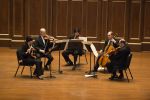| + | Program Notes |
Parallel Worlds for Flute, Two Violins, Viola, and Cello
Sebastian Currier
Born March 16, 1959 in Huntingdon, PA.
Composed in 2013; co-commissioned by The Chamber Music Society of Lincoln Center and the Boston Symphony Chamber Players
Premiered on March 20, 2014 in Phoenix, Arizona by flutist Tara Helen O’Connor, violinists Arnaud Sussmann and Ani Kavafian, violist Yura Lee, and cellist Mihai Marica.
Duration: 15 minutes
Sebastian Currier’s music has been performed at major venues worldwide by acclaimed artists and orchestras. Spanning both chamber and orchestral genres, Currier’s works have been performed by ensembles including the New World Symphony, San Francisco Symphony, Berlin Philharmonic, New York Philharmonic, and the Cassatt, Ying, and Kronos string quartets. Currier’s Deep-Sky Objects, 15 Minutes, Quanta, Flow, Links, and Ringtone Variations all received world premieres during the 2012–13 season. Highlights of the 2013–14 season include the premieres of Cadence, Fugue, Fade by the American Brass Quintet and Artificial Memory by the Dresher Ensemble. His violin concerto Time Machines, commissioned by Anne-Sophie Mutter, was premiered by the New York Philharmonic in June 2011, and a recording of the performance was released by Deutsche Grammophon the following September.
Currier has received many awards including the Grawemeyer Award (for the chamber piece Static), Berlin Prize, Rome Prize, a Guggenheim Fellowship, a fellowship from the National Endowment for the Arts, and an Academy Award from the American Academy of Arts and Letters, and has held residencies at the MacDowell and Yaddo colonies. He received a DMA from The Juilliard School; and from 1999–2007 he taught at Columbia University. He is artist-in-residence at the Institute for Advanced Study and is published by Boosey & Hawkes.
Currier writes: “The idea for Parallel Worlds started with the instrumental ensemble itself, flute and string quartet. The string quartet has remained, over centuries, one of the most written for and appreciated chamber ensembles. Though the reasons for this are various, I'm sure that one of them is the natural balance between the instruments: on the one hand it's a very unified sound, but on the other, it also allows for the independence of the individual string instruments. Add a flute to the mix and this all changes. When thinking about how to incorporate flute within the context of a string quartet I was struck by just how different a flute is then a string instrument. I mean this beyond the obvious facts of construction and sound production. Both instrument groups are designed to play similar material, articulate in analogous ways, even express similar things, yet they seem to occupy different worlds. Parallel worlds. This made me think of transcription: when transferring material between two instruments is a literal note-for-note correspondence the closest relation or do other less literal transformations better capture the essence of a passage on one instrument transcribed to another? I'm sure there are many valid answers to this question, but for my piece the answer was that to try to have literal correspondence was to lose some of the essence. In Parallel Worlds, therefore, the string quartet and the flute make music in different ways, parallel ways. The piece is in four movements. In each of them this parallel-but-different relation is approached in a variety of ways. In the third movement the strings present sustained chords while the flute intones elaborate figurations. Both groups are in their element: a group of strings slowly drawing their bows can give the impression of continuous sound; while the flute can not do that, its inherent agility allows it to execute elaborate figuration with flexibility and grace. And what makes the two groups not just different, but parallel is that while they unfold in their own way, they both are expressions of the same underlying harmonies.”
| + | Reviews |
From the Boston Classical Review:
"Parallel Worlds for flute and string quartet, which received its first performance a few weeks ago by the Chamber Music Society of Lincoln Center, explores the expression that is lost and gained when similar musical fragments are transcribed from one instrument to another.
It's an organic process that Currier has used in other works, such as his mixed quintet Static and the violin concerto Time Machine. Like those pieces, the landscape of Parallel Worlds is steeped in logic. Motives that appear in later movements are often foreshadowed at the ends of earlier ones, and the music's forms seem to circle back on themselves.Beyond its heady exterior, Parallel Worlds is awash with gorgeous colors. Sheets of harmonics flow from the strings while the flute sounds out long shimmering sustains overhead. Bent tones and glissandi are recurring themes in the work's four movements. Haldan Martinson (violin), Malcolm Lowe (violin), Steven Ansell (viola), and Sato Knudsen (cello) unleashed strings of tremolos, agitated statements, and glassy slides before passing them on to flutist Elizabeth Rowe, who added her own touches with flutter-tongue effects and velvety pitch bends.
Some of the ensemble's most exciting playing came in the finale, where angular string and flute patterns seem to spin in many directions at the same time. Both Rowe and the strings handled the jerky, pointillistic riffs with ease. Parallel Worlds is a work of finely honed craftsmanship, and one hopes it will receive many performances beyond Sunday's hearing." - Aaron Keebaugh
Download PDF Infosheet
Composer: Sebastian Currier
Instrumentation: flute and string quartet
Premiering Artists: Musicians of the Lincoln Center Chamber Music Society: flutist Tara Helen O’Connor, violinists Arnaud Sussmann and Ani Kavafian, violist Yura Lee, and cellist Mihai Marica and the Boston Symphony Chamber Players: flutist Elizabeth Rowe, violinists Malcolm Lowe and Haldan Martionson, violist Steven Ansell, and cellist Sato Knudsen.
Duration: 15"
Publisher Contact
www.boosey.com/pages/aboutus/help/contact.asp
Artist Contact
David Rowe Artist Management
http://davidroweartists.com/index.html

(Click for full size image)

(Click for full size image)
